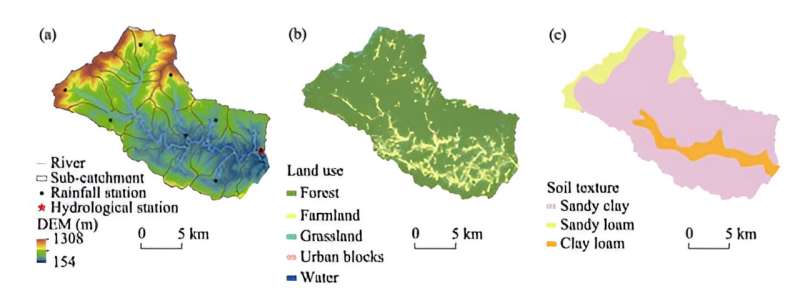This article has been reviewed according to Science X's editorial process and policies. Editors have highlighted the following attributes while ensuring the content's credibility:
fact-checked
proofread
Cracking the code of flash floods: New insights from China's mountainous regions

Recently, researchers have made breakthroughs in flash flood forecasting by studying how different rainfall patterns affect flash floods in China's mountainous regions. This research leads to the possibility of more accurate and localized flood warnings, potentially enhancing disaster preparedness and reducing the devastating effects of flash floods on at-risk communities.
Flash floods, marked by their sudden onset and devastating impact, pose a significant threat globally, particularly in China where they account for over 70% of flood-related fatalities and substantial economic losses. The complexity of predicting these events arises from the intricate interplay between intense, short-duration rainfall and the subsequent rapid catchment responses.
This underscores the urgent need for advanced research into rainfall patterns and flash flood dynamics to improve forecasting accuracy and develop effective early warning systems aiming to mitigate the severe consequences of these natural disasters.
In light of this, a study published in the Journal of Geographical Sciences in December 2023 offers a fresh perspective on flash flood forecasting by evaluating simulation capabilities with respect to rainfall variability in Anhe Catchment, a small mountainous region in southeastern China.
This study combined multivariate statistical analysis and hydrological simulations to meticulously evaluate the capabilities of two advanced hydrological models (Xinanjiang hydrological model, XAJ, and China Flash Flood hydrological Model, CNFF) and predict flash flood responses under these diverse rainfall conditions.
The findings reveal a significant proficiency of both models in accurately simulating water balances, hydrographs, flash flood behavior indices, and flood dynamics indices for flash flood events triggered by extended periods of uniform rainfall. However, the models faced difficulties in precisely forecasting flash flood behaviors associated with short, intense bursts of rainfall.
The essence of this research underscores the complexity of flash flood phenomena, driven by the distinct characteristics of the identified rainfall patterns. Through the application of the XAJ and CNFF models, the study highlights the challenges in bridging the gap between model simulations and the erratic nature of intense rainfall events.
Dr. Wang Xuemei, the lead author, emphasizes the critical nature of understanding the intricacies of rainfall-induced flash floods for improved prediction and management. "Our findings reveal the significant influence of rainfall temporal patterns on flash flood dynamics, highlighting the need for tailored forecasting approaches in different hydrological settings," she states.
This research offers significant advancements in flash flood forecasting, providing a nuanced understanding of how different rainfall patterns affect flash flood genesis and progression. Such insights are invaluable for developing more accurate and region-specific flood prediction tools, ultimately enhancing disaster preparedness and mitigation strategies.
More information: Xuemei Wang et al, Evaluating flash flood simulation capability with respect to rainfall temporal variability in a small mountainous catchment, Journal of Geographical Sciences (2023). DOI: 10.1007/s11442-023-2188-5
Provided by IGSNRR CAS




















